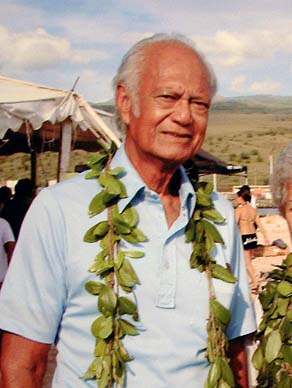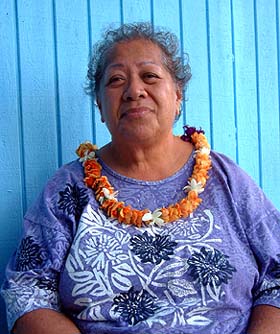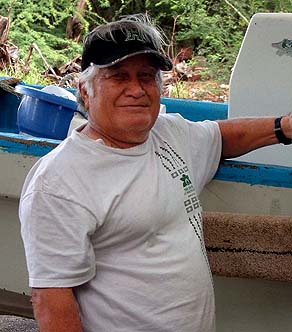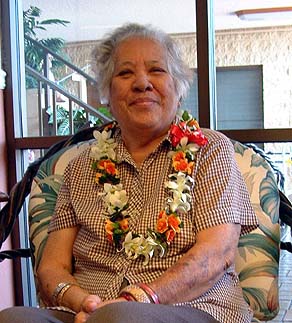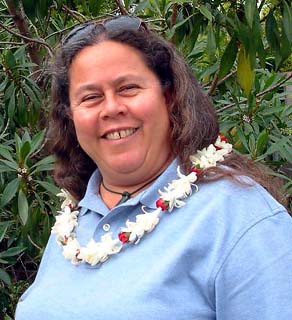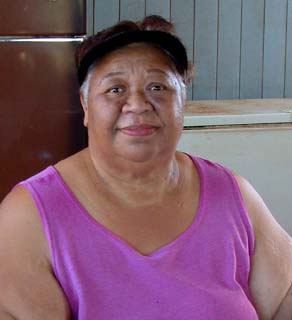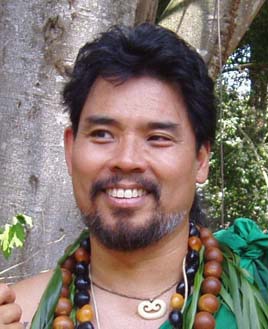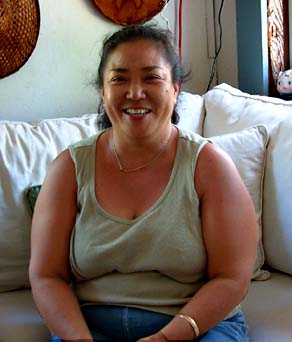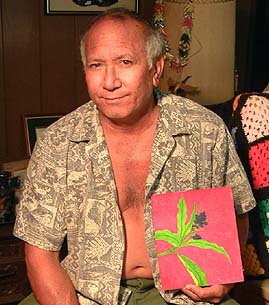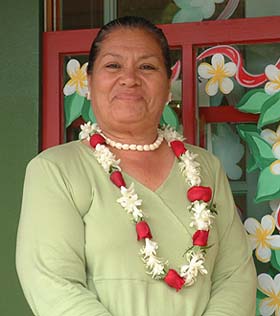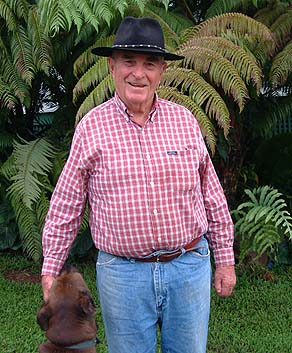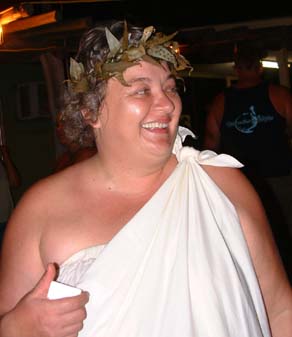 |
 |
 |
|||||
| Guides to Kawaihae | |
|
|
|
Pacific Worlds was very pleased to have the assistance of the following people to guide us through Kawaihae:
|
||
|
|
||
|
|
William "Papa" Akau: "I was born in Waiemi on January 15, 1927. Waiemi, that’s up in Waimea. Parker Ranch has a big stable there, they used to take care of thoroughbred horses. So my Dad worked there. My full name is William Ahyou Akau. Great-Great grandfather is pure Chinese. In 1928 the family moved here in Kawaihae, and I’ve live here ever since. It was beautiful before. We farmed and raised animals. I used to fish with our grandfather, great grandfather. I learned a lot from them as I grew up. Everybody in the community was always doing the same thing. It was close knit together, as a family. "After the War, I did boat building and ferrying the boats back from Kawaihae to Hilo. And a lot of fishing. Then in 1949, then I was called by the church and sent to Japan on a mission. When I came back I went to trade school. When I finished, I was called again on a mission, so I went to La‘ie on O‘ahu for three years. When I came home, there was a job opening with the State. "I worked for the State until 1984. I started off as maintenance and motor boat operator. Then when my Dad retired, the job of Harbor Master opened. I could have stayed right up to today. But because of the politics involved, I said ‘this is not for me.’ Dad’s gone, Mom’s gone, I say, ‘what else I need? I’ve done everything to help the family.’ So now I just relax. People said, ‘Oh, you’re too young to get out.’ I say, ‘I’m happy'."
|
| ‘Ilima Mo‘iha: “I was born in Kawaihae, a week after the bombing of Pearl Harbor, December 14, 1941. And it was blackout. My Dad was a civilian working for the military in Hilo, building the airport. I was raised in Kawaihae in my early years. Then we moved to Hilo because my Dad was a pastor, and we were there for a while and then we moved to Kohala. "I would say I was about eight years old when we moved to Kohala. We’ve been here ever since. But every opportunity we had, we would spend a weekend down at Kawaihae with my Uncle Alex. And they lived right on the beach. “My English name is Lee Ann—Lee from my Mom who was Lydia, and my Dad who was Andrew. My maiden name was Ako, and now I’m Mo‘iha. My husband is from Hana, Maui and I’m a pastor of a Pentecostal Church here in Kohala. I have three daughters, and now we have nine grand children and one great grandchild. We’ve been blessed.”
|
|
|
|
Eddie “Lala” La‘au, Jr.: "I was born here, right down here, where the shopping center is now. We had a house there. That’s where our fish market was. There used to be three houses down there. And when my mom leased the place out, I had to move back here. "Both of my parents were also from here, in Kawaihae. My Mom’s family was Mersberg. and my Dad was La‘au. My Dad was a fisherman. I learned from him. I used to work for the sport fishing boat too, on contract. Been there. It was good pay. I joined the Marines too, for four years. I went all the way up to Korea, 38th parallel, and came back. I was lucky—there was a Peace Treaty." Lala is the last traditional ‘opelu fisherman in Kawaihae. |
| Ululani ("Lani") Carvalho: "Ululani means ‘heavenly growth.’ My mother was Akau family, but my Daddy’s Ako. I’m Hawaiian, but my husband was Portuguese. I was born in Honolulu. Because my mom’s midwife was in Honolulu, every time she’s going to have a baby, we’d get on the boat and sail to Honolulu. After the baby was born, we stayed there for about a month and when the baby was well enough, my Dad would come down in the boat and we’d all go home on the boat, the Humu‘ula. "We were raised in Kawaihae. We lived right on the ocean, and my mother would get up every morning and go catch crabs for us. It was a beautiful life. But then we moved to Kohala, as my Dad was working there. I met my husband there. We have six children, three boys and three girls and one of my daughters is Jeannine. She is my second child. My oldest son lives in California, and I have one son who works at a Airport here in Kona."
|
|
|
|
Mel Kalahiki: "My name is Melvin David Lonokaiolohia Kalahiki. My mother, Elizabeth Kapeka Akau, was born in Kohala. My father, Mack Kamaka Kahulanui Kalahiki, was from Kahalu‘u, O‘ahu. Our family home was in Kalihi, which is where I was born. We had kuleana lands in Kahalu`u in taro and rentals. "When I was in the fifth grade I went to live with my Grandfather, William Paul Mahinauli Akau, at Kawaihae. My mother put me on the Humu‘ula in Honolulu. All travel was by boat at that time. She told me that when I got to Kawaihae to look for the man underneath the lantern, and that would be my cousin. That’s Bill Akau’s father. He was in charge of the pier and the post office at Kawaihae. "My grandfather was a retired policeman, born in North Kohala. In those days the police were on horseback. His area of jurisdiction was Kohala and Kawaihae. He was a very accomplished rider. Up until the year that he died, at 72, he was still riding. I also had four uncles working for Parker Ranch and one with Kahua Ranch. They all played a big part of my life experience. “I gained a lot from living with my Grandfather. Many of the things inside me today come from him. He knew a lot about his culture and passed on many things to me. To this day, I think of him every day. "I had the best of both worlds growing up in Kawaihae with my Grandfather and also being with my father’s family in Kahalu`u. Living in that ahupua‘a of Waihe‘e—the taro, the streams, the water, the fishing—all that makes for the balance of life."
|
| Hannah Kihalani Springer: "I’m a kama‘aina of the ahupua‘a of Kaupulehu* in North Kona. Our children are the sixth generation to live in the home that we live in. And we have a view to the place where our seven-times great-grand parents lie at rest in North Kona. Kawaihae, being situated in the District of South Kohala, is a place that our ancestors would come through occasionally as part of the marine economy of the kaha lands of North Kona, of which Kaupulehu is a part. I also have ancestral ties both to Kohala and to Parker Ranch. John Parker Palmer and his wife Kipikane were another set of my seven-times great-grandparents. "I did volunteer work at the Pu‘u Kohola heiau, which is at Kawaihae proper, so most of my practical ties to Kawaihae are from that work. "I’m a student of Anthropology and Geography, and presently sit as an appointed position on the Hawai‘i County Planning Commission. I’ve served an elective office as a Trustee of the Office of Hawaiian Affairs. I am a homemaker, with two kids—a 15 year old and a 14 year old—and a husband born in the Continental United States, but raised up in Honoka‘a. And I’m a life-long student of the natural and cultural histories of Hawai‘i." Kaupulehu is a contraction of many names, including Ka-‘ulu-pulehu ("the roasted breadfruit), Ka-imu-pu-lehu-a-ke-akua ("the expulsion of ashes from the imu of the god"), and Ka-‘upu-lehu ("the multitude of albatross).
|
|
|
|
Pua Tavares: "My full name is Jennie Lee Puanani. My family name was Akau, and it’s now Tavares. I was born and raised in Kawaihae. Besides me I have five more other siblings. And of course they all spread far and wide. I have three children and four grand children. My husband Louis is of Portuguese descent and he comes from Kohala. He comes from a very small family, but I come from a very big family. "All seven of us grew up here in Kawaihae. I was educated at Kohala High. And you know growing up here with seven of us, and Dad who worked on the Kahua ranch, in those days trying to raise a big family, the money was not there. They just made the minimum. My Dad used to go fishing, he used to go hunting, and that’s how he took care of his family. He used to saddle up his mule. He would take his gun, he would take his diving equipment—the spear gun with a sling—and he used to take his hunting dogs, And off he would go. And when he came back, he’s got a pig he caught, he got fish, and he got ‘opihi. He got all he went for, and he brought it all home for the family."
|
| Sam Gon: "I am a local-grown biologist working with the Nature Conservancy of Hawai‘i. I am their senior scientist and chief cultural advisor, and I help identify and protect those habitats for native plants and animals throughout the Hawaiian Islands. As a result, I’ve been able to go to all of the islands and visit first-hand almost all of the habitats where you can find native species, whether it’s underground or on the surface and forest or in a stream or along the coast. It’s just a wonderful, wonderful position. "I was born and raised on the island of O‘ahu but as early as high school began my exploration of the different islands and the different trails. Various people who knew their plants, particularly, started taking me around and showing me things. And I just never stopped wanting to know what these things are. "Every year I go to the ceremony at Pu‘u Kohola in Kawaihae, as a kahuna kakalaleo, chanter and practitioner of protocol for Kumu John Lake. We participate in the different rites that are held there. I find that personally very enriching. And I enjoy sharing what the natural world has to offer as the foundation of Hawaiian culture. "
|
|
|
|
Ku‘ulei Nagasawa McCarthy: "I’m from Kawaihae, born and raised here. I’ve been living here now for most of the last 46 years. My parents were from Kawaihae. They weren’t necessarily born here but they lived here for most of their lives. My mother’s grandparents are from here and now me and my children are from here too. My mother’s grandparents are the Akau family. My father's the Nagasawa Family. The Nagasawas lived in Kawaihae and fished in Kawaihae for quite a few years. They had a laundry business, when the War came because they took away their boats. "You come from Kawaihae, you come from Kawaihae. There’s not too many people that can say that they’re from Kawaihae because there were just very few people. And sometimes I see the people who moved away from here, because they come back and they stop and say, ‘Oh wow, you the only ones left?’ and I say ‘Yeah, we’re the only ones left.’ What’s going to happen after we’re gone?
|
| Craig White: "I’m a keiki o ka ‘aina, born here of the land, in Kohala. I guess I was probably about four or something and my family moved to Hilo. We stayed there about two or three years. I remember going to kindergarten over there and then my Dad got offered a job in Waimea, so we just moved over. He used to drive the sugar and molasses truck for Yamada Transfer Trucking. He was a council member for one time. "I was in the National Guard and served nearly four years. I was in Vietnam nine months. I guess you could say I saw some action. They gave me a Bronze Star. "A lot of information ends up in my head. I notice a lot of things. You’d be surprised what’s rolling around inside there. My astrologer says, ‘you either went and did a lot of things in your life, in many places and studied all these different things, or you’re an old soul.’ I said, I’ll go for the latter."
|
|
|
|
Jeannine Matos: "A lot of my growing up years were spent down at the old Kawaihae village. And even after we moved here to Kohala, our summers would be spent down at Kawaihae. And then after the natural bay got dredged, it was there no more. But we still had family who lived along the coast, so we’d spend summers there. "My brother and I were born here in North Kohala, but my mother’s brother and his family lived in Kawaihae, and so that’s why we spent summers there. We lived there when we were very, very little, and then my grandfather, my mother’s father, was an overseer for the County. And then he was working here in North Kohala, so we naturally moved over here. That’s the Ako family, from my grandfather. My Mom and my Aunt tell me that his name was actually Lau-Ako. Sometimes they would take on their mother’s name, and so I don’t know if my great-grandma was Ako. I’ll find out one day soon."
|
| Billy Paris: "I am William Hauwawaikaleoonamanuonakanahele Johnson Paris, Jr. Born in December 18, 1922. My mother went to Honolulu, spent three weeks there while she gave birth to me, then at three weeks of age, I came back to Kona, which has been my main place of life since then. I went to school in Honolulu, and served a stint in World War II, ended up fighting in Europe. "Isaac Davis’ nephew, John Davis, married my great-great grandmother Tutu Kauwe. She was the daughter of a chief and the chiefess who ruled the southern part of Kona and the northern part of Ka‘u. She and John Davis had two children, Charles and Eliza, and Eliza married my great grandfather William Johnson. They had five children, including my grandmother, who was one-fourth Hawaiian, and she married John D. Paris II, the son of John D. Paris I, who came to Hawaii by mistake. He was a missionary scheduled to go to the Oregon Territory. "John Palmer Parker had his daughter marry a man by the name of Fuller, and they had my great-great-grandmother, Martha Kekapaoka‘ahumanu Parker. And Martha married John Low, who is my great-grandfather, and they had about six children by that marriage. "Kona has been my home. I still do cattle ranching, along with other businesses."
|
|
|
|
Ku Kahakalau: "I was born in Honolulu, but I have a lot of family ties to this island. My great grandpa used to farm taro in Waipi‘o, and so it’s kind of coming home after two generations. Today, I’m the Director of Kanu o ka ‘Aina charter school. That’s one hat that I wear. I’m also the President of the non-profit that is developing a womb-to-tomb educational model here in Waimea, based on indigenous pedagogies "This now involves an age zero-to-five program, our K-12 school, and currently a teacher certification program, but that will expand in the near future to a Hawaiian university with other subject areas. Right now we’re just doing teacher education but we’re really looking at expanding that, so I am very much involved in that as a founder of all those various programs. "Our overall mission is the creation of a system of Hawaiian education. Currently we serve a thousand students on three islands, presenting a radically different way of education that’s actually very similar to how our kupuna learned before, but also aligning itself very well with some of the latest in twenty-first century educational paradigms. It’s really exciting."
|
Marion Greig Kelly: “I was born here in Honolulu. I am not Hawaiian, but I am part Polynesian. The name Greig is after my great grandfather. He went down to Rarotonga, picked up a family, and married the young girl in the family. They started a Coconut plantation on Fanning Island and. So my father is from Fanning Island. I also have relatives in Kawaihae—Eddie La‘au is a relative. “I lived for quite a while in my young life on a sugar plantation in Waialua. I finished a degree at the University of Hawai‘i, then World War II came along. I got married during the War, and right after the War, we went to New York City, where both of our children were born. Later we came home, and I finished a Masters degree at the University of Hawai‘i. “Kenneth Emory hired me at the Bishop Museum. That’s where I learned a lot about the Mahele. Later we did excavations, first at Kaua‘i, then at South Point, Ka‘u, and many other places. My work on the Hawaiian Islands was very important to my understanding of what happened to the land. “Now I’m 86 years old.” Marion is author of “E ho‘olono i ke kai hawanawana – Listen to the Whispering Sea: Historical survey of the Waimea to Kawaihae road corridor, Island of Hawai‘i.” This report is cited for information on Kawaihae.
|
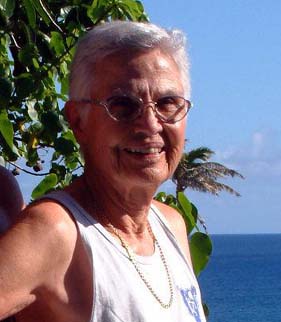 |
|
|
||
| Additional material is drawn from the following works: Samuel M. Kamakau, Ruling
Chiefs of Hawai‘i (1992) Let these people take you on a journey through Kawaihae and its culture. Turn the page to see the location of this land division.
|
||
|
|
||
|
|
|
|
|
|

|
| Kawaihae Home | Map Library | Site Map | Hawaiian Islands Home | Pacific Worlds Home |
|
|
|
|
|
|
|||
| Copyright 2006 Pacific Worlds & Associates • Usage Policy • Webmaster |
|||
